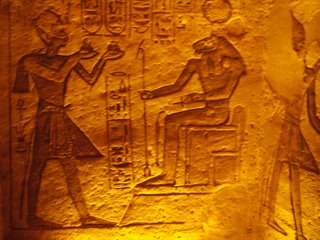Okay, so it's 3am, and i'm snug-as-a-bug-in-a-rug... until that damn hotel wake-up call jars me from my peaceful slumber. There's no such thing as a 10-minute snooze on this tour, it's just up-an-at-em. We've got a 3 hour 300Km bus ride ahead of us to Abu Simbel, in a police convoy no less. About 7 or 8 years ago there were some shootings at a popular tourist site in Luxor by some radical Islamic terrorists, killing a number of foreigners, Ever since then, in certain parts of Egypt, the only way to travel between certain tourist destinations is to get all of the group tours and individual travellers together in one big convoy, and speed down the desert highway. For those of you with your heart in your throat at the mentioning of this, don't worry. Ever since this system has been in place, there has been zero trouble.
Abu Simbel is about 40Km north of the Sudanese border, and there's not much there in the village, but just a mile or so outside of town are two of the most amazing temples with a pretty incredible story behind them. Back in 1274-1244BC, Pharoah Ramses the 2nd, built two enormous temples for himself, and his beloved wife Queen Nefertari, to honour the Gods Hathor and Amun, carving them out of the mountain on the west bank of the Nile. Over the centuries, the Nile and the desert sands shifted, and the temples were lost to human memory, until they were discovered again in the early 1800's AD. In the mid 1960's, the Egyptian Government decided they needed to dam the river to create more farming land to cope with the expanding population. Unfortunately, the newly created lake would flood over and destroy a good number of ancient monuments forever. So, they thought they'd move them!!


Not an easy task to uproot and relocate 3000 year old temples of monumental size, but with the help and funding of international governments (a cool US$40million) and UNESCO, they spent the next 20 years undertaking a huge engineering marvel and miracle of sorts, carefully deconstructing, block by block, storing, preparing, and reconstructing the temples, on higher ground, also specially prepared, with the exact same dimensions, facing the same direction to the exact millimetre. Abu Simbel's Temple of Ramses and Nefertari was one such temple. Honestly, to visit this site now, it has been recreated so faithfully, you would never know that the original site was 210metres away, under 65 metres of water in Lake Nasser dam. They're pretty speccy, to say the least, and well worth that damn 3am wake-up call and 600Km return journey.
Upon returning to Aswan, we almost immediately hit the banks of the Nile to jump on a felucca sailboat to cruise around the islands for the afternoon, and sip a coupla cold ones. This was a welcome respite from the hectic schedule we'd been keeping, to just lazily sail around, mingling with all the other felucca's, just gliding across the still, calm waters, with nary a breeze on the air, and the sun shining down a pleasant 20-something degree temperature. Come dusk, we disembarked on one of the islands where we would spend the evening with a local Nubian tribe in their village.
The land of Nubia occupied a large swathe of Northern Sudan and Southern Egypt. They're generally a nomadic group of people, and while not ever having their own country homeland so-to-speak, the frequent border disputes affected them greatly over the centuries. The final border agreement after World War 2 between Egypt and Sudan finally relegated them to the stauts of a people without a land to call their own. Then, there was the first dam built on the Nile in the 1920's, with the directive from the Government that they had to leave their villages and relocate to Sudan or to slected towns in Egypt, as they were going to be flooded forever. Then, the 2nd dam was built in the 1960's, bigger and greater then the first, and again they were forced to leave and relocate thier homes, truly displacing them from their homeland. Aswan was one of the options given to them, and many of them set up home on the islands in the middle of the Nile.
They are very distinct from Egyptians, looking very much more African than anything, with much darker skin, and generally taller and skinnier. It is a credit to them that they have managed to maintain their own cultural traditions, which we got to see a little of when we stayed for dinner. We did a short tour of the village, and visited the school that Imaginative Traveller sponsored, then sat down to dinner with them as they showed off their crafts and clothing and culinary delights. It was a very enjoyable evening, one of my favourite parts of the trip.
We then said our goodbyes and hopped back on the felucca, spending the night moored on the banks of the island on the Nile, sleeping under the stars in Southern Egypt....Nice!!
more in a bit.
Tony
peace love and happy faces
No comments:
Post a Comment